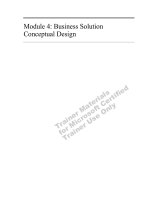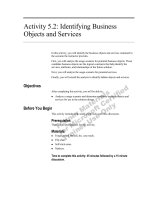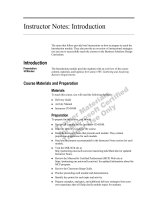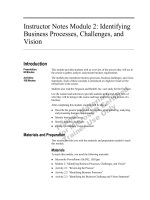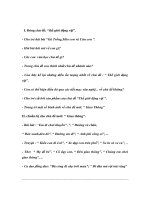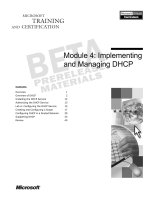Tài liệu Instructor Notes Module 4: Business - Solution Conceptual Design ppt
Bạn đang xem bản rút gọn của tài liệu. Xem và tải ngay bản đầy đủ của tài liệu tại đây (110.33 KB, 6 trang )
Instructor Notes Module 4: Business
Solution Conceptual Design
Introduction
In this module, students will learn about the basics of conceptual design, where
it fits in the Microsoft
®
Solutions Framework (MSF) Process Model, its purpose
and value in solution design, its steps and tasks, and its outputs and
deliverables. Students learn how the process of developing a conceptual design
will enable them to deliver solutions that match their customer’s requirements.
After completing this module, students will be able to:
!
Explain the need for conceptual design in the process of designing a
business solution.
!
Describe the role of conceptual design in the MSF Design Process Model.
!
Describe the steps of conceptual design.
!
Develop a future-state description of a business solution created through the
conceptual design process.
!
Develop a conceptual design for a business solution from the gathered and
analyzed information.
Materials and Preparation
This section provides you with the materials and preparation needed to teach
this module.
Materials
To teach this module, you need the following materials:
!
Microsoft PowerPoint
®
file P04_1608a.ppt
!
Module 4, “Business Solution Conceptual Design”
!
Activity 4.1, “Risks of Skipping Conceptual Design”
!
Activity 4.2, “Inputs to Conceptual Design”
!
Activity 4.3, “Value of Information Models”
!
Activity 4.4, “Creating a Future-State Usage Scenario”
Presentation:
125 Minutes
Activity:
100 Minutes
2 Instructor Notes Module 4: Business Solution Conceptual Design
2 Instructor Notes Module 4: Business Solution Conceptual Design
Preparation
To prepare for this module, you should:
!
Read all the materials for this module.
!
Complete the activities.
Instructor Notes Module 4: Business Solution Conceptual Design 3
Instructor Notes Module 4: Business Solution Conceptual Design 3
Activities
Activity 4.1: Risks of Skipping Conceptual Design
In this activity, students participate in a class discussion to identify the possible
risks of not doing conceptual design.
After completing this activity, students will be able to:
!
Articulate the value of conceptual design and the risks of not completing a
conceptual design.
!
To prepare for the activity
1. Complete the activity yourself.
2. Prepare examples from you experience.
3. Prepare some questions to foster a class discussion.
Activity 4.2: Inputs to Conceptual Design
In this activity, students will participate in a class discussion to identify the
possible inputs into the conceptual design process.
After completing this activity, students will be able to:
!
Identify the types of information and their sources that feed into the
conceptual design process.
!
To prepare for the activity
1. Complete the activity yourself.
2. Prepare examples from you experience.
3. Prepare some questions to foster a class discussion.
Activity 4.3: Value of Information Models
In this activity, students will participate in a class discussion to identify the
value of modeling as a way of analyzing information.
After completing this activity, students will be able to:
!
Articulate the role of information models in the analysis step of conceptual
design and the value of using those models.
!
To prepare for the activity
1. Complete the activity yourself.
2. Prepare examples from you experience.
3. Prepare some questions to foster a class discussion.
4 Instructor Notes Module 4: Business Solution Conceptual Design
4 Instructor Notes Module 4: Business Solution Conceptual Design
Activity 4.4: Creating a Future-State Usage Scenario
In this activity, students will use the provided use cases and usage scenarios for
the client billing process, along with the Ferguson and Bardell, Inc. case study,
to create future-state use cases and usage scenarios.
First, students will create future-state use cases for the client billing process.
This process begins with the consultant creating a timesheet and ends with the
customer receiving an invoice.
Next, students will create future-state usage scenarios for the solution required
by Ferguson and Bardell, Inc.
!
After completing this activity, students will be able to create a future-state
usage scenario.
!
To prepare for the activity
1. Prepare extra copies of the case study, the current-state use cases, and the
usage scenarios for any students who may not have their own copies.
2. Complete the activity yourself.
3. Review the suggested solution.
4. Prepare some questions to foster a class discussion.
Instructor Notes Module 4: Business Solution Conceptual Design 5
Instructor Notes Module 4: Business Solution Conceptual Design 5
Module Strategy
Use the following strategy to present this module:
!
Conceptual Design Basics
This provides an overview of the conceptual design phase. Spend the time
necessary to cover all of the points thoroughly, and be sure that by the time
you finish, your students have a clear grasp on the purpose, inputs, and
outputs of conceptual design. Providing a solid foundation in this section
will make the other sections go much more smoothly.
!
Activity 4.1: Risks of Skipping Conceptual Design
This discussion should help students understand the benefits of having a
conceptual design phase in the design of the solution, as well as the
potential risks of not having a conceptual design phase.
!
Conceptual Design Process
This section ties the conceptual design phase to the process model and
outlines the steps in the conceptual design phase. Students should grasp the
relationship to the process model fairly quickly, but might not attain the
same quick familiarity with the steps and deliverables. Do not get bogged
down in the steps and deliverables — they will be covered more thoroughly
in the upcoming sections. Simply introduce them in the context of a project
life cycle. Refer students to the research (gathering) and analysis steps that
were performed in Course 1585: Gathering and Analyzing Business
Requirements.
!
Conceptual Design Research
This section outlines the research step of the conceptual design phase. You
may need to spend some time on the concept of enterprise architecture
because some of the class may not be familiar with it. Also, emphasize the
expanded meaning of “user” discussed in the text so that students realize
that, during the research step, they identify all the stakeholders in the
solution. Finally, explore the concept of constraints as not only
technological, but also business based. You may want to prepare additional
examples of business constraints and requirements so that students begin to
develop the ability to “see” such constraints and requirements when doing
research. Emphasize that constraints are not necessarily negative; they only
help define the boundary of the solution space.
!
Activity 4.2: Inputs to Conceptual Design
This discussion will enable students to think about the inputs to the
conceptual design phase. You should be prepared to provide examples based
on your own experience.
6 Instructor Notes Module 4: Business Solution Conceptual Design
6 Instructor Notes Module 4: Business Solution Conceptual Design
!
Conceptual Design Analysis
This section introduces the analysis step of conceptual design. Walk through
the process carefully and thoroughly, making sure that students understand
the validate-identify-model-create workflow for this step. They should also
completely grasp the concepts of a use case, a usage scenario, and a
workflow model. When you are comfortable that they understand the
analysis step, you should move to the last topic of documenting the current
state. Emphasize that documenting the current state is beneficial, and that
understanding the current state is never optional. Explain that the ability to
execute each step of the design process is important. The necessity and
depth of coverage should be determined by the size of the project and the
team’s experience level.
!
Activity 4.3: Value of Information Models
This discussion provides you with the opportunity to confirm that the
students understand the analysis step of conceptual design.
!
Conceptual Design Optimization
This section introduces the optimization step of conceptual design. (If there
were a clear line, and there really is not, between the Envisioning Phase of
the MSF Process Model and the Design Phase of the MSF Process Model, it
would be at this step.) The text accompanying the slides makes a number of
points, all of which need to be emphasized and understood. Point out that
many projects should be cancelled at the end of the optimization step if it is
discovered that the future state’s expected return on investment does not
justify the cost of the project. Take your time working through this section
and help students grasp the value of optimization. This is also the point in
the project when the team shifts from working primarily with the current
state of the business environment and begins designing the future-state
solution.
!
Activity 4.4: Creating a Future-State Usage Scenario
This activity presumes that students know how to create current-state usage
scenarios. However, there is an example in the activity for those students
who have not attended Course 1585: Gathering and Analyzing Business
Requirements. The suggested solution for this exercise is not the only one
possible. Build a class consensus on the future-state usage scenario.
